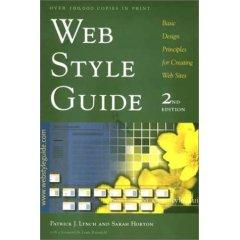Web Style Guide: Basic Design Principles For Creating Web Sitesby Patrick J. Lynch and Sarah Horton 
Download Book
(Respecting the intellectual property of others is utmost important to us, we make every effort to make sure we only link to legitimate sites, such as those sites owned by authors and publishers. If you have any questions about these links, please contact us.)
link 1
link 2
About Book
Amazon.com
In 160 pages of expert instruction, authors Patrick J. Lynch and Sarah Horton put the essence of the Yale University Center for Advanced Instructional Media's wonderful online site design guide into traditional print. The book begins the presentation of its helpful and forward-looking advice with a discussion of the overall process of defining the objectives and users of your Web site, as well as the goals you will use to measure your progress. The authors then use time-tested, traditional print concepts to clearly illustrate how to make your site interface welcoming and efficient. High-quality illustrations show how to design for overall style and professional appeal. The sections on typography and editorial style set this manual apart from many Web style guides with attention to the fine details that separate the good sites from the great. Multimedia elements and cascading style sheets (CSS) are covered, but within the overall context of building a fine site--not with the usual hype. Media compression and delivery are addressed at a high level with concrete suggestions on formats, frame rates, and image sizes for a well-balanced approach to multimedia. One of the great things about using this guide is that the actual site it is based on is available. You can read about a thoughtfully-written topic and then go online to see the concepts in action. Web Style Guide delivers some of the most holistic coverage of site design you'll find. --Stephen W. Plain
J. D. Biersdorfer, New York Times
Web Style Guide covers all the basic elements of creating a Web site. . . . Readers are first offered the notions of content and interface design before they are asked to contemplate the traditional eye-candy favorites of page layout, graphics and multimedia. . . . Authoritative factoids are sprinkled throughout . . . [and] serve to ground the book in logic while elevating it above some of the brightly colored hyperactive Web design manuals out there. . . . The book is sort of an Elements of Style for Webmasters, and the authors even invoke that classic handbook's injunction to 'prefer the specific to the general, the definite to the vague, the concrete to the abstract.'
Donald A. Norman, author of The Design of Everyday Things and The Invisible Computer
"At last, a book on the design of Web sites with the viewer in mind."
Stephen W. Plain, Web Development Editor, Amazon.com. A top-10 choice for 1999
"Helpful and forward-looking advice."
Deborah Lynne Wiley, Online
"The Web would be an easier world to navigate if all Web designers read this book."
Edward R. Tufte, Yale University
"A style guide for the interface with real long-run value, showing us deep principles of design rather than simply fashion and technology."
Donald A. Norman, author of The Design of Everyday Things and The Invisible Computer
"At last, a book on the design of Web sites with the viewer in mind....[It] intelligently and succinctly discusses all those topics so badly neglected by most Web sites."
Craig Locatis, National Library of Medicine, National Institutes of Health
"One of the few resources that discusses organizing information on the Web in ways that serve users. This guide addresses a critical need in a practical way."
Book Description
This essential guide for Web site designers provides practical, concise advice on creating well-designed and effective Web sites and pages. Focusing on the interface and graphic design principles that underlie the best Web site design, this book offers invaluable help on a full range of issues, from planning and organizing goals to design strategies for a site to the elements of individual page design. This second edition includes guidelines on designing for accessibility, strategies for maintaining a Web site, details on using style sheets, and much more. This book grew out of the widely used and highly praised Web site on site design created by the Center for Advanced Instructional Media at Yale University (info.med.yale.edu/caim/manual/). At this site, readers will continue to find updated color illustrations and examples to complement and demonstrate points made in the book, as well as useful and current online references.
Yale University press
This essential guide for Web site designers provides practical, concise advice on creating well-designed and effective Web sites and pages. Focusing on the interface and graphic design principles that underlie the best Web site design, this book offers invaluable help on a full range of issues, from planning and organizing goals to design strategies for a site to the elements of individual page design. This second edition includes guidelines on designing for accessibility, strategies for maintaining a Web site, details on using style sheets, and much more. This book grew out of the widely used and highly praised Web site on site design created by the Center for Advanced Instructional Media at Yale University (info.med.yale.edu/caim/manual/). At this site, readers will continue to find updated color illustrations and examples to complement and demonstrate points made in the book, as well as useful and current online references.
About the Author
Patrick J. Lynch is director of Web Design and Development at the Yale University School of Medicine. Sarah Horton is instructional technology specialist in Curricular Computing at Dartmouth College. She is also the author of Web Teaching Guide, available from Yale University Press.
Related Free eBooks | 












SEND A COMMENT
PLEASE READ: All comments must be approved before appearing in the thread; time and space constraints prevent all comments from appearing. We will only approve comments that are directly related to the article, use appropriate language and are not attacking the comments of others.